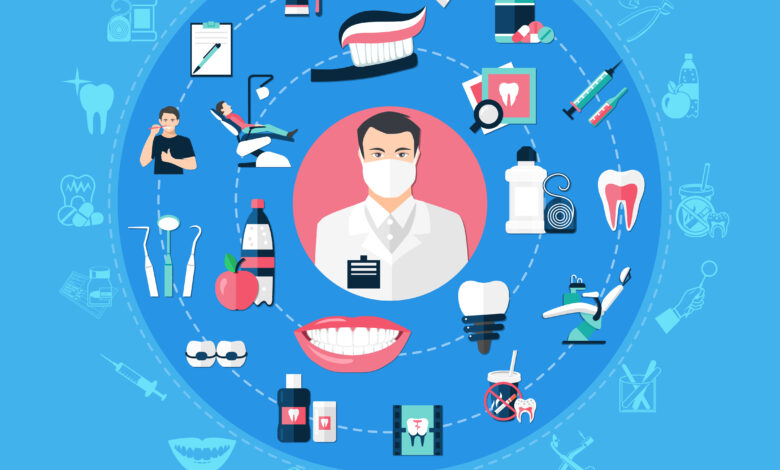A Comprehensive Guide to Dental Practice Marketing in 2025

Understanding the Basics of Dental Marketing
Defining Dental Marketing
Dental practice marketing is all about connecting with potential patients and keeping the current ones engaged. It’s not just about getting people through the door but also about building relationships that last. Think of it as creating a community around your practice. This involves everything from traditional advertising to digital strategies and even word-of-mouth.
Importance of a Strong Online Presence
In today’s digital age, having a strong online presence is non-negotiable for marketing for dentists. Patients are more likely to search for dental services online before stepping into a clinic. A well-designed website, active social media profiles, and positive online reviews can significantly boost your practice’s visibility. It’s like your virtual handshake with potential patients, making that first impression count.
Key Components of a Dental Marketing Strategy
A successful dental marketing strategy is like a well-oiled machine, with several moving parts working in harmony. Here are some key components:
- Website Optimization: Ensure your website is user-friendly and optimized for search engines. This helps in attracting organic traffic.
- Content Marketing: Share informative and engaging content that addresses common dental concerns and educates patients.
- Social Media Engagement: Use platforms like Instagram and Facebook to interact with your audience and showcase the human side of your practice.
- Email Newsletters: Keep patients informed about new services, promotions, and dental health tips.
Building a solid dental marketing strategy isn’t just about attracting new patients; it’s about nurturing the relationship with existing ones and turning them into loyal advocates for your practice.
Leveraging Digital Tools for Effective Dental Marketing
Utilizing SEO and SEM
When it comes to attracting more patients, dental SEO services and SEM are like your secret weapons. Think of SEO as the art of making your dental practice visible when potential patients search online. It’s all about using the right keywords, like ‘best dentist near me,’ to climb up the search results. SEM, on the other hand, involves paid strategies like Google Ads to get quick visibility. Together, they ensure your practice is seen by the right people at the right time.
Key Points:
- SEO: Focus on local keywords and optimize your website’s content.
- SEM: Utilize Google Ads for immediate visibility and targeted reach.
- Combination: Use both strategies to cover short-term and long-term goals.
The Role of Social Media in Dental Marketing
Social media isn’t just for selfies and memes anymore. For a dental marketing company, platforms like Instagram and Facebook are goldmines. They offer a way to connect with patients on a personal level, showcase your practice’s personality, and even educate about dental health. Regular posts, engaging stories, and interactive content can keep your audience hooked.
Benefits of Social Media:
- Builds a community around your practice.
- Provides a platform for patient testimonials and reviews.
- Offers a space for educational content and promotions.
Incorporating AI and Chatbots
AI isn’t just for tech geeks—it’s revolutionizing dental marketing too. Chatbots, for instance, can handle patient inquiries 24/7, book appointments, and even send reminders. This means your staff can focus on in-clinic tasks while still providing excellent patient service online.
Embracing AI and chatbots not only boosts efficiency but also enhances the patient experience by offering instant support and information.
How AI Can Help:
- Automates routine tasks, freeing up staff time.
- Provides immediate responses to patient queries.
- Enhances patient engagement with personalized interactions.
Creating Engaging Content for Dental Marketing
Developing a Content Calendar
Creating a content calendar is like setting up a roadmap for your dental practice’s marketing journey. It helps you plan what to post and when, ensuring consistency and relevance. A well-organized calendar can boost your efficiency and keep your content strategy on track. Start by identifying key themes and topics that align with your practice’s goals. Consider seasonal events, patient questions, and new service launches. Then, map out a schedule that balances different types of content, such as educational articles, patient stories, and promotional posts. This proactive approach not only keeps your team aligned but also helps in maintaining a steady flow of engaging content that resonates with your audience.
Types of Content That Resonate with Patients
Patients connect with content that speaks directly to their needs and concerns. Here are some content types that can make a significant impact:
- Educational Articles: These provide valuable insights into dental health, helping patients understand procedures and care tips.
- Patient Testimonials: Real-life stories build trust and show potential patients what they can expect.
- FAQs: Address common patient questions to reduce anxiety and improve understanding.
Using Video and Visuals to Enhance Engagement
Visual content is a powerful tool in dental marketing. Videos and images can break down complex topics and make them more accessible. Consider creating short explainer videos about common procedures or using visuals to showcase before-and-after transformations. Infographics can also be a great way to present data or step-by-step guides in a visually appealing manner. Remember, engaging visuals not only capture attention but also improve retention, making your content more memorable.
Engaging content is not just about filling space on your website or social media. It’s about creating meaningful connections with your patients, addressing their concerns, and building trust through transparency and information. By focusing on what matters to your audience, you can craft a content strategy that not only attracts new patients but also retains existing ones.
Building Trust Through Patient Reviews and Testimonials
Encouraging Patient Feedback
Getting feedback from your patients is like gold for your dental practice. Why? Because it shows you care about their experience and are open to making improvements. Start by making it easy for patients to leave reviews. You can do this by sending a friendly follow-up email or text after their appointment, asking them to share their thoughts. Make sure to include direct links to your review pages like Google My Business or Yelp. This way, patients don’t have to go searching for where to leave a review.
Showcasing Testimonials on Your Website
Once you’ve got some great reviews, don’t just leave them sitting there. Put them to work! Display these testimonials prominently on your website. This can be on your homepage, a dedicated testimonials page, or even sprinkled throughout your site. It’s like having happy patient stories working for you, convincing new visitors that your practice is the right choice.
Responding to Reviews Effectively
Now, let’s talk about handling those reviews. Whether they’re singing your praises or pointing out areas for improvement, responding promptly and professionally is key. For positive reviews, a simple thank you goes a long way. For negative ones, acknowledge their concern, apologize if necessary, and offer a solution. This shows you’re committed to patient care and willing to make things right. Remember, your response is not just for the reviewer, but for everyone else who reads it too.
Building trust isn’t just about collecting reviews; it’s about how you interact with them. Be genuine and responsive, and your patients will feel valued and heard.
Maximizing ROI with Targeted Advertising
Understanding Google Ads for Dentists
Google Ads can be a powerful tool for dentists aiming to attract new patients. By targeting specific keywords like “dentist near me” or “emergency dental services,” practices can appear at the top of search results when potential patients are actively looking for services. Using location-based targeting ensures that your ads reach individuals who are within a convenient distance from your practice. This can be as specific as a five-mile radius, ensuring that your marketing budget is spent on reaching the most relevant audience.
Social Media Advertising Strategies
Social media platforms offer unique opportunities to connect with potential patients. Facebook and Instagram, for example, allow for highly targeted advertising based on demographics, interests, and behaviors. Here are some tips for effective social media advertising:
- Use engaging visuals to capture attention.
- Craft messages that speak directly to your audience’s needs.
- Regularly analyze ad performance and adjust strategies accordingly.
Measuring the Success of Your Campaigns
To truly maximize ROI, it’s crucial to measure the effectiveness of your advertising campaigns. This involves setting clear goals and key performance indicators (KPIs) such as the number of new patient inquiries or appointments booked. By using analytics tools, you can track which ads are driving the most traffic and conversions.
Setting clear marketing goals and KPIs is not just helpful; it’s necessary for understanding the success of your campaigns and making informed decisions about where to allocate your marketing budget.
Personalizing Patient Experiences in Dental Marketing
Tailoring Communications to Patient Needs
In today’s fast-paced world, generic communication just doesn’t cut it anymore. Patients want to feel like they’re more than just a number. Personalized messaging makes patients feel valued and understood. Think about it—sending a birthday greeting or a reminder about a past treatment shows you remember them. It’s like getting a handwritten note instead of a mass email. A few ideas to personalize your communication:
- Use patient names in emails and messages.
- Send reminders for check-ups based on individual schedules.
- Share tips or articles related to a patient’s specific dental concerns.
Using Data Analytics for Personalization
Data is your best friend when it comes to personalization. With the right tools, you can gather insights on patient preferences and behaviors. This isn’t about being creepy; it’s about being helpful. By analyzing data, you can:
- Identify which services a patient might need based on their history.
- Understand patient demographics to tailor marketing campaigns.
- Track engagement to improve future interactions.
Enhancing Patient Engagement Through Personal Touches
Adding a personal touch can turn a mundane visit into a memorable experience. It’s those little things that patients remember and talk about. Consider these strategies:
- Offer personalized welcome packs for new patients.
- Remember personal details, like a patient’s favorite music, and play it during their appointment.
- Follow up with a personal call or message after a procedure to check on recovery.
Personalizing patient experiences isn’t just a trend; it’s a necessity in today’s dental marketing world. Making patients feel special encourages loyalty and keeps them coming back. It’s all about creating a connection that goes beyond the chair.
Staying Ahead with the Latest Dental Marketing Trends
Embracing New Technologies
In 2025, dental practices are diving headfirst into the tech world. Keeping up with the latest tech isn’t just about having the newest gadgets—it’s about improving patient care and streamlining operations. From AI-driven appointment scheduling to virtual reality tools for patient education, these innovations are reshaping how dentists connect with their patients. Consider the following tech tools:
- AI scheduling assistants for efficient appointment management
- Virtual reality for patient education and anxiety reduction
- Online platforms for seamless patient communication
Adapting to Changes in Consumer Behavior
Patients today are more informed and have higher expectations. They want convenience and transparency from their healthcare providers. This means dental practices need to be more agile in their marketing approaches. Practices should:
- Offer online booking and telehealth options
- Provide transparent pricing and treatment plans
- Engage with patients through personalized digital content
Forecasting Future Trends in Dental Marketing
Looking ahead, the focus will be on hyper-personalized patient experiences. By analyzing data trends and patient feedback, practices can tailor their services to meet specific needs. This might include:
- Personalized treatment plans based on patient history
- Targeted marketing campaigns using AI analytics
- Enhanced patient experiences through feedback loops
Staying ahead in dental marketing requires not only adopting new technologies but also understanding and anticipating patient needs. By doing so, practices can build stronger relationships and ensure long-term success.
Wrapping It Up
So, there you have it. Marketing your dental practice in 2025 isn’t just about putting up a flashy website or posting a few times on social media. It’s about creating a genuine connection with your patients and understanding what they really need. By focusing on personalized experiences, using the latest tech, and keeping an eye on your online presence, you’re setting yourself up for success. Remember, it’s the little things like patient reviews and engaging content that can make a big difference. Keep adapting, stay curious, and your practice will thrive in this ever-changing landscape. Good luck out there!
Frequently Asked Questions
What are the most important dental marketing trends for 2025?
In 2025, dental marketing is all about creating personalized experiences for patients, using AI to help engage them, and making video content for teaching and promoting. It’s also important to make sure your site works well with voice search.
How can I use digital tools to grow my dental practice?
You can grow your dental practice by using digital tools like SEO, letting patients book appointments online, and talking to them on social media.
What are the best ways to keep patients interested on social media?
To keep patients interested on social media, share personal stories, create fun posts like quizzes, and make sure you post often to build a community.
How can I make my dental website show up higher in search results?
To make your dental website show up better, use the right keywords, write good content, make sure your site works on phones, and get links from other good websites.
Can patient reviews really help my dental practice?
Yes, patient reviews can make your dental practice look trustworthy and show that patients are happy, which is important for new patients looking for care.
What are some key takeaways for dental marketing in 2025?
Some key things for dental marketing in 2025 are making things personal for patients, using new tech like online booking, having a strong online presence, and getting good reviews from patients.



